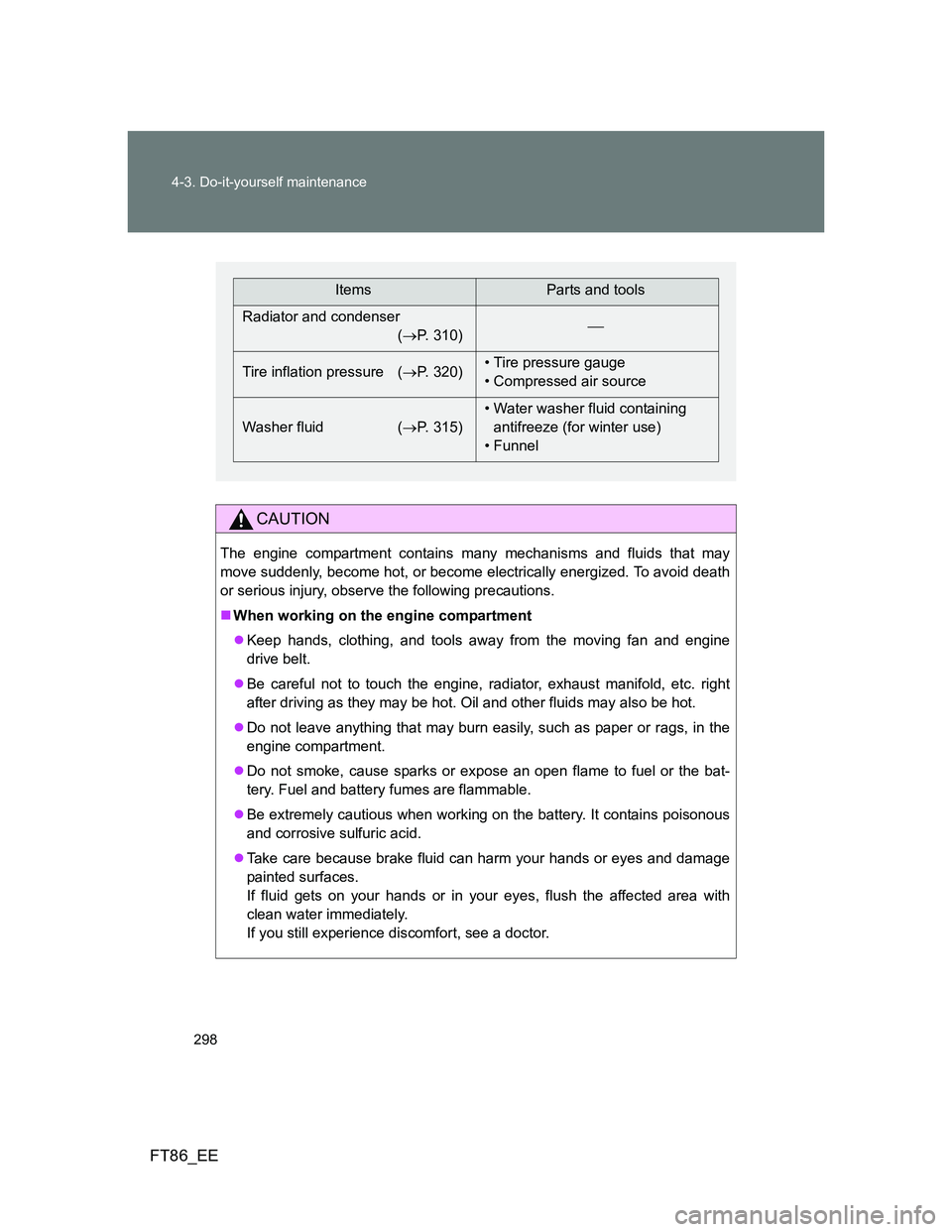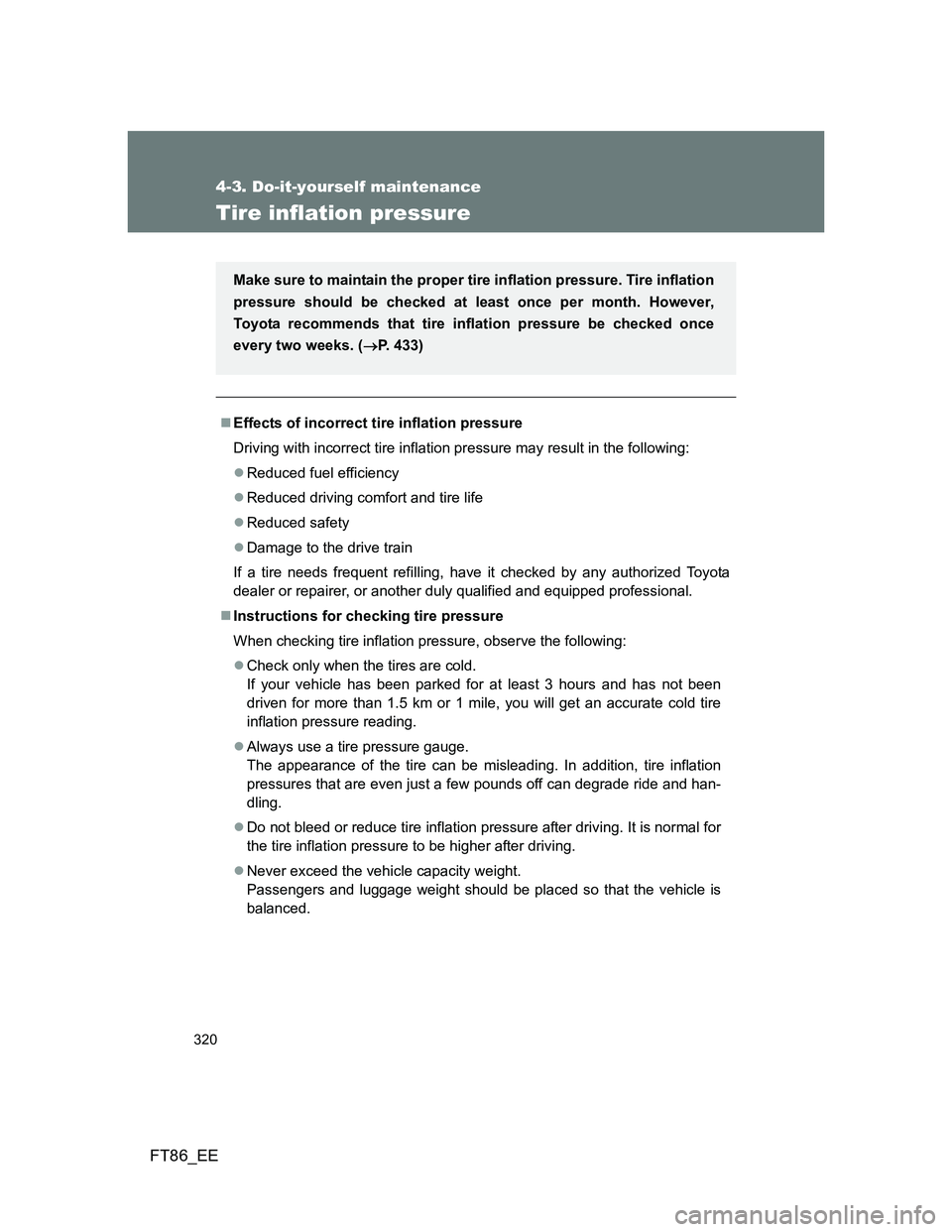Page 4 of 452

TABLE OF CONTENTSIndex
FT86_EE
4
4-1. Maintenance and care
Cleaning and protecting
the vehicle exterior ........... 284
Cleaning and protecting
the vehicle interior ............ 288
Cleaning and protecting
the Alcantara
® area .......... 292
4-2. Maintenance
Maintenance
requirements..................... 294
4-3. Do-it-yourself
maintenance
Do-it-yourself service
precautions ....................... 297
Hood ................................... 300
Positioning a floor jack ........ 302
Engine compartment........... 304
Tires .................................... 317
Tire inflation pressure ......... 320
Wheels ................................ 322
Air conditioning filter ........... 324
Wireless remote control/
electronic key battery........ 326
Checking and replacing
fuses ................................. 330
Light bulbs .......................... 3385-1. Essential information
Emergency flashers ........... 358
If your vehicle needs to
be towed .......................... 359
If you think something
is wrong............................ 366
Fuel pump shut off
system.............................. 367
5-2. Steps to take in an
emergency
If a warning light turns
on or a warning buzzer
sounds... ......................... 368
If you have a flat tire
(vehicles with a
spare tire) ......................... 377
If you have a flat tire
(vehicles with an
emergency tire puncture
repair kit) .......................... 385
If the engine will not
start .................................. 400
If the shift lever cannot
be shifted from P .............. 403
If you lose your keys .......... 404
If the electronic key does
not operate properly ......... 405
4Maintenance and care5When trouble arises
Page 7 of 452
FT86_EE
7
Tires
Rotation
Replacement
Temporary repair
Inflation pressure
P. 317
P. 377
P. 385
P. 320
Rear window defogger P. 258
Trunk P. 56
Doors P. 53
Fuel filler door P. 84
Turn signal lights P. 193
: If equipped
License plate lights P. 211
Tail lights P. 211
Rear fog light P. 218
Page 233 of 452

233 2-4. Using other driving systems
2
When driving
FT86_EE
CAUTION
When the VSC and/or brake LSD function is activated
The slip indicator light flashes. Always drive carefully. Reckless driving may
cause an accident. Exercise particular care when the indicator light flashes.
When the TRC/VSC systems are turned off
Be especially careful and drive at a speed appropriate to the road condi-
tions. As these are the systems to ensure vehicle stability and driving force,
do not turn the TRC/VSC systems off unless necessary.
Replacing tires
Make sure that all tires are of the specified size, brand, tread pattern and
total load capacity. In addition, make sure that the tires are inflated to the
recommended tire inflation pressure level.
The ABS, TRC and VSC systems will not function correctly if different tires
are installed on the vehicle.
Contact any authorized Toyota dealer or repairer, or another duly qualified
and equipped professional for further information when replacing tires or
wheels.
Handling of tires and suspension
Using tires with any kind of problem or modifying the suspension will affect
the driving assist systems, and may cause a system to malfunction.
Page 283 of 452
4Maintenance and care
283
FT86_EE
4-1. Maintenance and care
Cleaning and protecting
the vehicle exterior ......... 284
Cleaning and protecting
the vehicle interior .......... 288
Cleaning and protecting
the Alcantara
® area ........ 292
4-2. Maintenance
Maintenance
requirements................... 294
4-3. Do-it-yourself
maintenance
Do-it-yourself service
precautions ..................... 297
Hood ................................. 300
Positioning a floor jack ...... 302
Engine compartment......... 304
Tires .................................. 317
Tire inflation pressure ....... 320
Wheels .............................. 322
Air conditioning filter ......... 324
Wireless remote control/
electronic key battery...... 326
Checking and replacing
fuses ............................... 330
Light bulbs ........................ 338
Page 298 of 452

298 4-3. Do-it-yourself maintenance
FT86_EE
CAUTION
The engine compartment contains many mechanisms and fluids that may
move suddenly, become hot, or become electrically energized. To avoid death
or serious injury, observe the following precautions.
When working on the engine compartment
Keep hands, clothing, and tools away from the moving fan and engine
drive belt.
Be careful not to touch the engine, radiator, exhaust manifold, etc. right
after driving as they may be hot. Oil and other fluids may also be hot.
Do not leave anything that may burn easily, such as paper or rags, in the
engine compartment.
Do not smoke, cause sparks or expose an open flame to fuel or the bat-
tery. Fuel and battery fumes are flammable.
Be extremely cautious when working on the battery. It contains poisonous
and corrosive sulfuric acid.
Take care because brake fluid can harm your hands or eyes and damage
painted surfaces.
If fluid gets on your hands or in your eyes, flush the affected area with
clean water immediately.
If you still experience discomfort, see a doctor.
ItemsParts and tools
Radiator and condenser
(P. 310)
Tire inflation pressure (P. 320)• Tire pressure gauge
• Compressed air source
Washer fluid (P. 315)• Water washer fluid containing
antifreeze (for winter use)
• Funnel
Page 319 of 452

319 4-3. Do-it-yourself maintenance
4
Maintenance and care
FT86_EE
CAUTION
When inspecting or replacing tires
Observe the following precautions to prevent accidents.
Failure to do so may cause damage to parts of the drive train, as well as
dangerous handling characteristics, which may lead to an accident resulting
in death or serious injury.
Make sure to install 4 tires that are of the specified size, and that all 4 tires
are the same size, same maker, same brand and tread pattern.
Do not use tire sizes other than those recommended by Toyota.
Only use radial tires.
Do not mix summer, all season and snow tires.
Do not use tires that have been used on another vehicle.
Do not use tires if you do not know how they were used previously.
NOTICE
Driving on rough roads
Take particular care when driving on roads with loose surfaces or pot holes.
These conditions may cause losses in tire air pressure, reducing the cush-
ioning ability of the tires. In addition driving on rough roads may cause dam-
age to the tires themselves, as well as the vehicle’s wheels and body.
Low profile tires and wheels (vehicles with 17-inch tires)
Low profile tires may cause greater damage than usual to the tire wheel
when receiving impact from the road surface. Therefore pay attention to the
following:
Be sure to use proper tire inflation pressure. If tires are under-inflated, they
may be damaged more severely.
Avoid pot holes, uneven pavement, curbs and other road hazards. Failure
to do so can lead to severe tire and wheel damage.
If tire pressures become low while driving
Do not continue driving, or your tires and/or wheels may be ruined.
Page 320 of 452

320
4-3. Do-it-yourself maintenance
FT86_EE
Tire inflation pressure
Effects of incorrect tire inflation pressure
Driving with incorrect tire inflation pressure may result in the following:
Reduced fuel efficiency
Reduced driving comfort and tire life
Reduced safety
Damage to the drive train
If a tire needs frequent refilling, have it checked by any authorized Toyota
dealer or repairer, or another duly qualified and equipped professional.
Instructions for checking tire pressure
When checking tire inflation pressure, observe the following:
Check only when the tires are cold.
If your vehicle has been parked for at least 3 hours and has not been
driven for more than 1.5 km or 1 mile, you will get an accurate cold tire
inflation pressure reading.
Always use a tire pressure gauge.
The appearance of the tire can be misleading. In addition, tire inflation
pressures that are even just a few pounds off can degrade ride and han-
dling.
Do not bleed or reduce tire inflation pressure after driving. It is normal for
the tire inflation pressure to be higher after driving.
Never exceed the vehicle capacity weight.
Passengers and luggage weight should be placed so that the vehicle is
balanced.
Make sure to maintain the proper tire inflation pressure. Tire inflation
pressure should be checked at least once per month. However,
Toyota recommends that tire inflation pressure be checked once
every two weeks. (P. 433)
Page 321 of 452
321 4-3. Do-it-yourself maintenance
4
Maintenance and care
FT86_EE
CAUTION
Proper inflation is critical to save tire performance
Keep your tires properly inflated. Otherwise, the following conditions may
occur and result in an accident causing death or serious injury.
Excessive wear
Uneven wear
Poor handling
Possibility of blowouts resulting from overheated tires
Poor sealing of the tire bead
Wheel deformation and/or tire separation
A greater possibility of tire damage from road hazards
NOTICE
When inspecting and adjusting tire pressure
Be sure to reinstall the tire valve caps.
Without the valve caps, dirt or moisture could get into the valve and cause
air leakage, which could result in an accident. If the caps have been lost,
replace them as soon as possible.